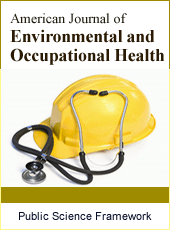American Journal of Environmental and Occupational Health
Articles Information
American Journal of Environmental and Occupational Health, Vol.2, No.1, Jan. 2017, Pub. Date: Jun. 15, 2017
Physical Activity, Nutritional Status and Their Relationship with Hypertension in Adult Men in District Peshawar
Pages: 1-6 Views: 2073 Downloads: 398
[01]
Fazal Dad, Department of Human Nutrition, Faculty of Nutrition Sciences, the KPK Agricultural University, Peshawar, Pakistan.
[02]
Saleem Khan, Department of Human Nutrition, Faculty of Nutrition Sciences, the KPK Agricultural University, Peshawar, Pakistan.
[03]
Ijaz Habib, Department of Human Nutrition, Faculty of Nutrition Sciences, the KPK Agricultural University, Peshawar, Pakistan.
Hypertension or high blood pressure is the condition in which systolic blood pressure is ≥ 140 mmHg and diastolic blood pressure is ≥ 90 mmHg regardless of the age. Hypertension means that no medical cause can be found to explain the raise of blood pressure. It is an important public health problem globally which is highly prevalent and is a major contributor to morbidity and mortality in both developed and developing countries. In this study related to physical activity, nutritional status and their relationship with hypertension in adult men in district Peshawar was evaluated. A total of 600 individuals (300 hypertensive and 300 non-hypertensive) as case control were randomly selected. The anthropometric measurements, physical activity, dietary intake, socioeconomic and demographic data were recorded to evaluate the relationship and risk factors associated with hypertension. The mean (± S.D.) values of body mass index (BMI) of hypertensive and non-hypertensive individuals were 26.7 ± 2.81 and 25.2 ± 2.86 kg/m2, respectively. The results showed a significant difference in the mean weight and body mass index (BMI) of hypertensive and non-hypertensive individuals. The results from medical history and clinical examination of hypertensive individuals (98.3%) showed positive family and smoking history. The mean values of physical activity status of hypertensive and non-hypertensive individuals as sedentary, light, moderate and heavy 74.67%, 13.0%, 12.3%, 0% and 25.08%, 26.09%, 35.79% and 13.04% respectively which showed that the higher percentage of hypertensive were involved in sedentary to light physical activities comparatively non-hypertensive individuals which were involved in moderate to strenuous physical activities. The mean (± S.D) values of caloric, carbohydrates, protein and fats intakes of both hypertensive and non-hypertensive were (2197.4 ± 327.9 and 2104.0 ± 350.9 kcal) 312.0 ± 68.7 and 310.3 ± 70.1 g) (66.3 ± 22.4 and 73.7 ± 21.2 g) (76.3 ± 21.8 and 63.09 ± 25.8 g) respectively. The results of the study showed the relationship of hypertension with higher body mass index (BMI), family, medical and smoking history, low physical activity and unhealthy dietary pattern are the main contributing factors in the development of hypertension.
Dietary Intake, Hypertension, Nutritional Status, Physical Activity
[01]
American Heart Association guidelines (AHA-2012)
[02]
Ben. Dov. I., G. Ehud., S. Ayelet, S., S. Dov., and G. Marked weight reduction lowers resting and exercise blood pressure in morbidly obese subjects Am J Hypertens. (2000) 13 (3): 251-255.
[03]
Expert committee on physical status, the use and interpretation of anthropometry WHO technical report 1983, series no 854, World Health Organization, Geneva
[04]
Goplan et al, (1985). Nutritive Value of Indian Foods.
[05]
Hajjar. I., J. M. Kotchen and T. A. Kotchen. (2006). Hypertension: trends in prevalence, incidence and control. Ann. Rev. Public Health 27: 465-90
[06]
Krishnan, A., R. Gorg and A. Kahandaliyanage (2013). Hypertension in the South-East Asia Region: an overview. Regional Health Forum 17: 7-14.
[07]
Shwe, S., Ohnmar., K. K. Than., T. T. Sein., A. Thu., K. M. Maung., M. S. Lwin and H. L. Tun. (2004). Prevalence of hypertension in two selected villages of Kayin State, Myanmar. Regional
[08]
Health Forum WHO South-East Asia Region. 8 (1)
[09]
Hussain et al, (1990). Pakistani Food Composition Table.
[10]
WHO. (2010). WHO Country office in Pakistan. June (29).

ISSN Print: Pending
ISSN Online: Pending
Current Issue:
Vol. 2, Issue 2, March Submit a Manuscript Join Editorial Board Join Reviewer Team
ISSN Online: Pending
Current Issue:
Vol. 2, Issue 2, March Submit a Manuscript Join Editorial Board Join Reviewer Team
| About This Journal |
| All Issues |
| Open Access |
| Indexing |
| Payment Information |
| Author Guidelines |
| Review Process |
| Publication Ethics |
| Editorial Board |
| Peer Reviewers |


